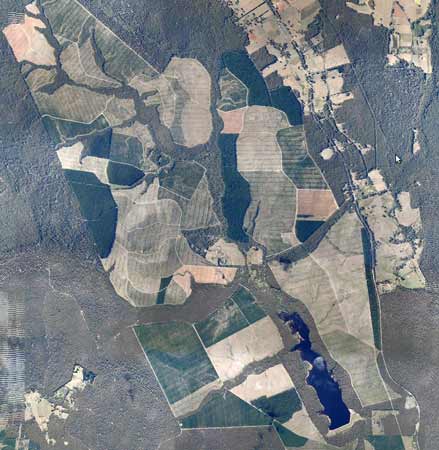

Early 2012: Image Source Nearmap Korweinguboora Reservoir surrounded by 1400ha of Hancock pine. Hancock Watch estimate that 5.6 tonnes of Hexazinone would have been used in this plantation between 2002 and 2010. However due to the 2004-06 pollution incident, use of Hexazinone supposedly ceased in April/May 2005, meaning that 2-3 years worth of hexazinone occurred (~1.5 tonnes). Hexazinone was still being detected in October 2008, over three years after the herbicide had supposedly stopped being used. The question also remains if the plantation successfully grows without the use of hexazinone why is hexazinone required elsewhere through pine plantations of the Hancock estate.
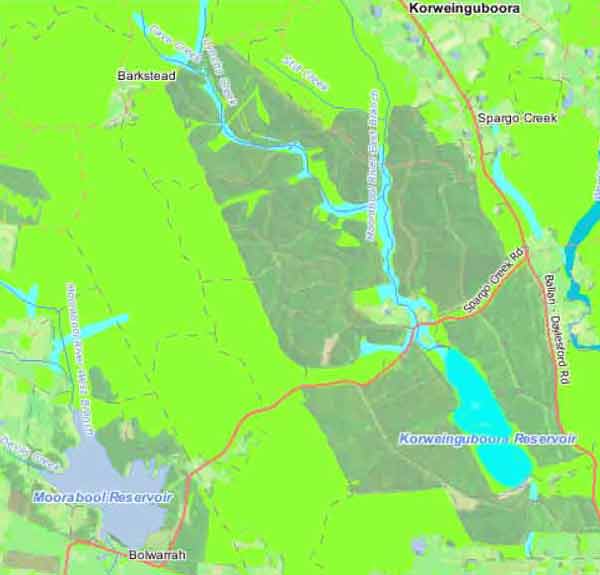
Other herbicides likely to be used at Korweinguboora over the 10 year logging period include; Clopyralid, Glufosinate Ammonium, Glyphosate, Metsulfuron Methyl and Triclopyr. At maximum label rates over 1400 hectares of pine, 3.57 tonnes of Clopyralid, 1.4 tonnes of Glufosinate Ammonium, 5.04 tonnes of glyphosate, 0.084 tonnes of Metsulfuron Methyl and 4.2 tonnes of Triclopyr. That's about 14 tonnes of herbicides at the maximum rate!!! or averaging out to 1.775 tonnes a year for 8 years. (Moorabool Reservoir is managed by Central Highlands Water).
If the plantation is fertilised, fertilisers containing trace elements of cadmium, lead, mercury and fluoride could also be used.
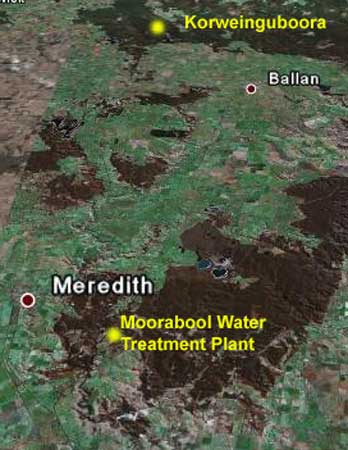
Google Earth image showing Moorabool River (She Oaks) Water Supply Catchment. Korweinguboora plantation in the background and Moorabool Water Treatment Plant in the foreground. Hexazinone has been detected at Moorabool Water Treatment Plant, travelling a distance of 50km from Korweinguboora.
(Please note: detection of some samples of hexazinone were found 50km from pollution source).
(Source: Barwon Water - Freedom of Information Request 2006 by Friends of the Earth Melbourne).
*Hexazinone detected by Barwon Water between December 2004 - October 2008 (46 months). (Source: Freedom of Information Request 2007 by Friends of the Earth Melbourne).
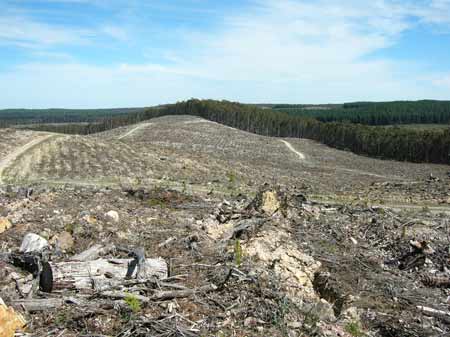
|
Herbicide
|
Date
|
Result
|
Site Name
|
|
Hexazinone
|
9/10/08
|
0.014ug/L
|
Moorabool WTP Combined Water Raw
|
|
Herbicide
|
Date
|
Result
|
Site Name
|
|
Hexazinone
|
4/6/08
|
0.02 ug/L
|
Moorabool WTP Combined Raw Water
|
|
Hexazinone
|
6/2/08
|
0.018 ug/L
|
Moorabool WTP Combined Raw Water
|
|
Hexazinone
|
5/12/07
|
0.019 ug/L
|
Moorabool WTP Combined Raw Water
|
|
Hexazinone
|
7/11/07
|
0.026 ug/L
|
Moorabool WTP Combined Raw Water
|
|
Hexazinone
|
17/10/07
|
0.016 ug/L
|
Korweinguboora Outlet
|
|
Hexazinone
|
17/10/07
|
0.036 ug/L
|
Bostok Outlet
|
|
Hexazinone
|
3/10/07
|
0.074 ug/L
|
Moorabool WTP Combined Raw Water
|
|
Hexazinone
|
5/9/07
|
0.02 ug/L
|
Moorabool WTP Combined Raw Water
|
|
Hexazinone
|
15/8/07
|
0.029 ug/L
|
Bostok Outlet
|
|
Hexazinone
|
6/8/07
|
0.067 ug/L
|
Moorabool WTP Combined Raw Water
|
|
Herbicide
|
Date
|
Result
|
Site Name
|
|
Hexazinone
|
4/7/07
|
0.06 ug/L
|
Moorabool WTP Combined Raw Water
|
|
Hexazinone
|
2/5/07
|
0.11 ug/L
|
Moorabool WTP Combined Raw Water
|
|
Hexazinone
|
7/3/07
|
0.11 ug/L
|
Moorabool WTP Combined Raw Water
|
|
Hexazinone
|
7/2/07
|
0.13 ug/L
|
Moorabool WTP Combined Raw Water
|
|
Hexazinone
|
15/12/06
|
0.15 ug/L
|
Moorabool WTP Combined Raw Water
|
|
Hexazinone
|
9/11/06
|
0.2 ug/L
|
Moorabool WTP Combined Raw Water
|
|
Hexazinone
|
5/10/06
|
0.082 ug/L
|
Moorabool WTP Combined Raw Water
|
|
Hexazinone
|
4/9/06
|
0.032 ug/L
|
Moorabool WTP Combined Raw Water
|
|
Hexazinone
|
8/8/06
|
0.11 ug/L
|
Moorabool Combined Pre Treatment
|
|
Herbicide
|
Date
|
Result
|
Site Name
|
|
Hexazinone
|
7/6/06
|
0.11 ug/L
|
Moorabool Combined Pre Treatment
|
|
Hexazinone
|
7/6/06
|
0.084 ug/L
|
Stony Creek Reservoir #3
|
|
Hexazinone
|
3/5/06
|
0.17 ug/L
|
Moorabool Combined Pre Treatment
|
|
Hexazinone
|
3/5/06
|
0.19 ug/L
|
Stony Creek Reservoir #3
|
|
Hexazinone
|
5/4/06
|
0.12 ug/L
|
Moorabool Combined Pre Treatment
|
|
Hexazinone
|
5/4/06
|
0.18 ug/L
|
Stony Creek Reservoir #3
|
|
Hexazinone
|
7/3/06
|
0.058 ug/L
|
Moorabool Combined Pre Treatment
|
|
Hexazinone
|
7/3/06
|
0.16 ug/L
|
Stony Creek Reservoir #3
|
|
Hexazinone
|
7/2/06
|
0.2 ug/L
|
Stony Creek Reservoir #3
|
|
Hexazinone
|
4/1/06
|
0.071 ug/L
|
Moorabool Combined Treatment
|
|
Hexazinone
|
4/1/06
|
0.2 ug/L
|
Stony Creek Reservoir #3
|
|
Hexazinone
|
13/9/05
|
0.12 ug/L
|
Stony Creek Reservoir #3
|
|
Hexazinone
|
7/3/05
|
0.044 ug/L
|
Bostok Outlet
|
|
Hexazinone
|
7/3/05
|
0.056 ug/L
|
Bostok Outlet
|
|
Hexazinone
|
7/3/05
|
0.058 ug/L
|
Bostok Outlet
|
|
Hexazinone
|
7/3/05
|
0.047 ug/L
|
Bungal Creek @ Crossing on Slocombe Track
|
|
Hexazinone
|
7/3/05
|
0.086 ug/L
|
East Moorabool River
|
|
Hexazinone
|
7/3/05
|
0.051 ug/L
|
Korweinguboora Inlet
|
|
Hexazinone
|
7/3/05
|
0.2 ug/L
|
Korweinguboora Outlet
|
|
Hexazinone
|
7/3/05
|
0.67 ug/L
|
Korweinguboora Outlet
|
|
Hexazinone
|
7/3/05
|
0.86 ug/L
|
Korweinguboora Outlet
|
|
Hexazinone
|
7/3/05
|
0.24 ug/L
|
Stony Creek Reservoir #3
|
|
Hexazinone
|
7/3/05
|
0.15 ug/L
|
Stony Creek Reservoir #2
|
|
Hexazinone
|
7/3/05
|
0.22 ug/L
|
Upper Stony Creek Reservoir #3
|
|
Hexazinone
|
4/3/05
|
0.19 ug/L
|
Bannockburn basin
|
|
Hexazinone
|
4/3/05
|
9.4 ug/L
|
Korweinguboora Hancock Site
|
|
Hexazinone
|
4/3/05
|
0.1 ug/L
|
Montpellier Basin #4
|
|
Hexazinone
|
31/1/05
|
0.082 ug/L
|
Bungal Creek @ Crossing on Slocombe Track
|
|
Hexazinone
|
31/1/05
|
0.37 ug/L
|
Korweinguboora Inlet
|
|
Hexazinone
|
31/1/05
|
1.3 ug/L
|
Korweinguboora Outlet
|
|
Hexazinone
|
31/1/05
|
0.22 ug/L
|
Stony Creek Reservoir #3
|
|
Hexazinone
|
31/1/05
|
0.18 ug/L
|
Upper Stony Creek Reservoir #2
|
|
Hexazinone
|
31/1/05
|
0.21 ug/L
|
Upper Stony Creek Reservoir #3
|
|
Hexazinone
|
1/12/04
|
0.32 ug/L
|
Stony Creek Reservoir #3
|
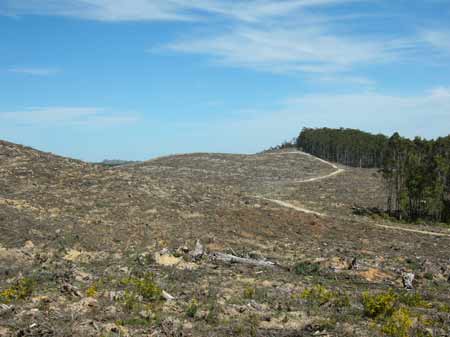
October 2006: McQueens Road
Barwon Region Water Authority Briefing Note 21 March 2005
Subject: Hexazinone and plantations in the Moorabool catchment
Objective: To provide a briefing on the low-level detection of hexazinone in the Moorabool catchment.
Background: In July 2004 the scope of the drinking water quality monitoring program was extended to include all pesticides that have NATA accredited testing methodologies and are listed in the Australian Drinking Water Guidelines that have either been detected on occasions in Australian drinking water or their likely use would indicate that they may be occasionally detected. Among the new chemicals added to the monitoring program was hexazinone, which has an Australian Drinking Water Guideline of 2 ug/L and a health value of 300 ug/L.
In December 2004, 0.32 ug/L of hexazinone was detected at the inlet to the Moorabool Water Treatment Plant.
Hexazinone is a contact and residual herbicide which is readily absorbed by leaves and roots. Since it is tolerated by conifers it is widely used to control herbaceous and woody weeds in Pinus Radiata plantations. Hexazinone has a relatively long half-life in soil (up to 232 days), is highly soluble in water and does not readily adsorb to soil or accumulate in biota. Consequently it is more mobile in the environment than many other pesticides. Hancock Victorian Plantations Pty Ltd applies hexazinone as a dry granular (slow release) formulation in the first few years of planting around Korweinguboora Reservoir. Based on the landuses in the Moorabool catchment and the close association of the chemical with forestry, the plantation is considered to be the sole significant source. Barwon Water subsequently contacted Hancock Victorian Plantations Pty Ltd and the application of hexazinone has since ceased.
Repeat testing of hexazinone in the Moorabool catchment has confirmed the herbicide to be present in low levels, well below the Australian Drinking Water Guideline and health values. However, the long half-life and slow release formulation warrant concern that the level of hexazinone may increase if further application were to occur.
Actions Arising
1. Notice to discontinue hexazinone application
It is proposed that Barwon Water serve Hancock Victorian Plantations Pty Ltd with a notice to permanently discontinue the application of hexazinone in all Barwon Water water supply catchments. The notice would be forumlated under the authority of the Water Act 1989. Section 169(1): Notice of contravention for water supply protection
An Authority may, by notice in writing to any person, require -
(a) that an activity carried out on any land owned or occupied by that person be discontinued; or
(b) the removal of any substance or thing -
if the carrying out of the activity, or the presence of the substance of thing, is, in the opinion of the Authority, likely to affect the purity of the Authority's water supply system.
In the correspondance of the notice, Barwon Water would also request Hancock Victorian Plantations Pty Ltd continue to notify Barwon Water of their plantation operations program, in order for both organizations to agree on plantation operations that protect waterways from contamination.
2. Notification of Victorian Government Departments
It is further proposed that the Manager Chemical Standards of the Victorian Department of Primary Industries be notified of the hexazinone results. The results may assist the department in formulating agricultural chemical controls. The Department of Human Services would also be copied into the notification, as a matter of courtesy in relation to communicating water quality issues with the Victorian Government.
3. Notification of the Australian Pesticide and Veterinary Medicines Authority (APVMA).
The APVMA is responsible for assessing all pesticides prior to registration to allow sale and use in Australia. Similar to the DPI, the results may assist the authority in formulating agricultural chemical controls.
Recommendation
That the future actions outlined above be implemented as described...
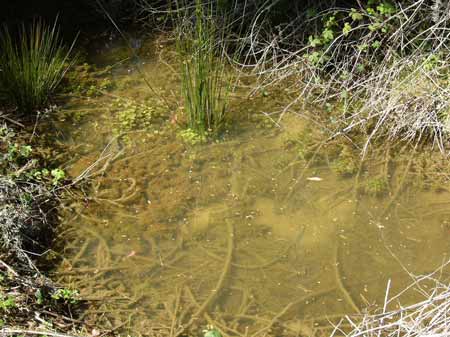
October 2006: Geelong drinking water inside the plantation.
Poison in water supply (Geelong Advertiser 25 August 2006) By Peter Begg.
Barwon Water has taken action against a pine plantation operator in one of its catchments after a poisonous herbicide was detected in drinking water.
The water authority confirmed yesterday it took action against a plantation operator in April 2005.
In a first since the relevant act came into force, Barwon Water issued Hancock Victorian Plantations with a notice of Contravention for Water Protection. The water authority has since reached agreement with Hancock plantations not to use certain herbicides in its catchment areas. This followed low-level detection of the herbicide hexazinone in raw water samples from the Korweinguboora Reservoir catchment, near Ballarat.
Barwon Health said the amount of the herbicide detected in tests was such a low level that it did not threaten public health. Hancock plantations confirmed yesterday that they have since agreed to use other herbicides that were less persistent.
But environment group Friends of the Earth said yesterday the herbicide hexazinone had been used for a number of years, and there was little known about its long-term effects. A spokesman for Friends of the Earth, Anthony Amis, said the group learned about the pollution from a Freedom of Information request to Barwon Water. Mr Amis said information gained from the FoI showed Barwon Water had detected hexazinone on 34 seperate occasions since December 2004. "It has shown up consistently now for 18 months," Mr Amis said. 'Ten samples during that time have been detected at the inlet to the Moorabool Water Treatment Plant near Meredith."
Barwon Water wrote to Hancock Victorian Plantations in April, 2005, informing the operator they were in 'Contravention of Water Supply Protection". Barwon Water executive manager water systems Carl Bicknell said yesterday that providing safe drinking water and protecting customers' health were Barwon Water's highest priorities.
***PRESS RELEASE 23/8/06***
FRIENDS OF THE EARTH/WOMBAT FOREST SOCIETY
PESTICIDES POLLUTING GEELONG DRINKING WATER
Environmental groups are concerned that traces of hexazinone, a herbicide associated with weed control in pine plantations has been consistently detected by Geelong’s Drinking Water Authority, Barwon Water, since December 2004.
Friends of the Earth Melbourne learnt about the pollution from a Freedom of Information request to Barwon Water. The results have disturbed Friends of the Earth Plantations Research Officer, Anthony Amis.
Mr Amis said "From the information gained from the FoI, Barwon Water has detected Hexazinone on 34 separate occasions since December 2004. It has shown up consistently now for 18 months. 10 samples during that time have been detected at the inlet to the Moorabool Water Treatment Plant near Meredith.”
"It appears that the pollution is occurring from a massive pine plantation owned by Hancock Victorian Plantations at Korweinguboora, located south of Daylesford. We are 99.99% sure that this is the source of the pollution” said Mr Amis.
“What is alarming is that the pesticide is being detected 50km downstream near Meredith. Is it also getting through the system into people’s drinking and washing water?” Mr Amis asked.
"Our organisation has had concerns about this plantation for some time” said Mr Amis. About 1400 hectares of the plantation lie within the She Oaks Proclaimed Water Catchment, which includes the headwaters to the Moorabool River East Branch, which feeds into Barwon Water's supply network. Friends of the Earth estimates that over 4 tonnes of the herbicide has and will be used on the plantation over a 8-9 year period.
Once plantations are logged, herbicides are used to knock out competing weeds. Hexazinone is usually applied one year or so after logging. It is usually used to kill Silver Wattle and Dogwood which may be regenerating amongst the pine trees. The herbicide is usually applied in a granual form, with release of the herbicide occurring during rainfall.
“Everytime it rains at Korweinguboora we could expect to see traces of Hexazinone leaching offsite into the Barwon Water supply system” said Mr Amis. “This is a totally unsustainable outcome. These plantations are an environmental nightmare” Mr Amis added.
The herbicide is residual with a half life of 200 days or more. Hexazinone is also highly soluble in water, meaning that it is more readily transported away from the application site by rainfall. "Approximately half of the plantation has been logged in the past few years conceivably meaning that pollution will continue to occur off the site for some years to come" said Mr Amis.
Mr Amis added that "although only one of the readings breached the Australian Drinking Water Guideline Limit of 2 parts per billion, people should be concerned about the cumulative effect if this poison is ingested. If this herbicide continues to be used in the catchment, in a worse case scenario we could be looking at leaching continuing for another decade, because logging the plantation won't cease until 2009/2010. This means that a cumulatative effect could occur with people being exposed consistently at low levels. What is the health impact of this? Mr Amis asked.
"Our greatest concern is the potential health impacts on pregnant women, young children and people with chemical sensitivities. We want the pesticide banned from domestic water supplies” Mr Amis said.
According to the US EPA, Hexazinone is a severe eye irritant and has been placed in Toxicity Category I (the highest of four levels) for primary eye irritation. It is slightly toxic through the acute oral route (Toxicity Category III) and very mildly toxic through the acute dermal and acute inhalation route.
"It is an outrage that a US based company can threaten a cities drinking water for 18 months and get away with it” said Mr Amis. “The other issue of concern is the ecological impact of the herbicide on aquatic ecosystems, particularly on freshwater algae. Hexazinone pollution of the Moorabool River could cause a ripple effect through the aquatic food chain. We also have concerns about the impacts on the Daylesford Mineral Springs, as the plantations are also located in a recharge area” said Mr Amis.
"It appears that Barwon Water have been asleep at the wheel on this” said Mr Amis. I first raised this matter with Barwon Water in 2002. The Geelong Advertiser also raised the matter in October 2002 and Barwon Water were quoted then as saying, “there was no chance of contamination as aerial spraying of pesticide would not be used around Korweinguboora reservoir”. “How wrong they were” Mr Amis stated. “The pollution has been caused by ground based operations”.
“At a meeting with Barwon Water as late as July 1st last year they stressed to representatives of Friends of the Earth, Otways Environment Council and Gellibrand Clean Water Network that plantations within water supplies are considered to be a low risk, almost a non-event. Why would they make these claims when they were already aware that Hancock Victorian Plantations had been polluting Barwon Water’s domestic supply for 7 months with hexazinone and that they had served Hancock Victorian Plantations with a contravention notice two months earlier? Something doesn’t seem right. I feel that I have been totally misled by Barwon Water” Mr Amis said. “Could it be that Barwon Water wanted this kept quiet because they are also managers of pine plantations surrounding Bostok Reservoir?”
“This information needs to be made public. People have an absolute right to know what could be threatening their health”. Mr Amis said.
The FoI revealed that a Barwon Water Briefing Note stated that Hexazinone had been detected as early as December 2004. Barwon Water stated; "Repeat testing of hexazinone in the Moorabool catchment has confirmed the herbicide to be present in low levels, well below the Australian Drinking Water Guideline and health values. However, the long half-life and slow release formulation warrant concern that the level of hexazinone may increase if further application were to occur."
Barwon Water then wrote to Hancock Victorian Plantations in April 2005 serving a contravention notice under section 169(1) of the Water Act 1989 on Hancock to permanently discontinue the application of Hexazinone in all Barwon Region Water Authority water supply catchments.
In February 2006 this notice was lifted by Barwon Water, despite Hexazinone still be detected in samples taken by Barwon Water in January and February 2006. “Why was the notice lifted when the pesticide was still being detected?” Mr Amis asked.
Mr Amis added; "The residents of Geelong should be under no illusion that the quality of their drinking water will be safe as long as this plantation continues to be sprayed. Several other herbicides are also used in the plantation including Clopyralid, Glyphosate, Metsulfuron Methyl and Triclopyr.
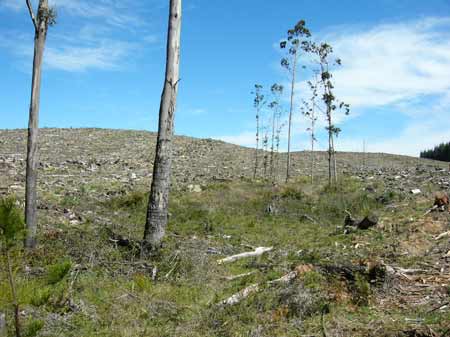
October 2006: Typical buffers at Korweinguboora in Geelong's drinking water supply.
Information on Korweinguboora Plantation can be found at;
http://www.hancock.forests.org.au/directory/ballarat/LEGL93-54.html
The plantation is leased by Hancock Victorian Plantations, who purchased the logging and spraying rights from the Victorian Plantation Corporation in 1998. The plantation was established in the 1970’s, with herbicides used at that time being the infamous 2,4,5-T.
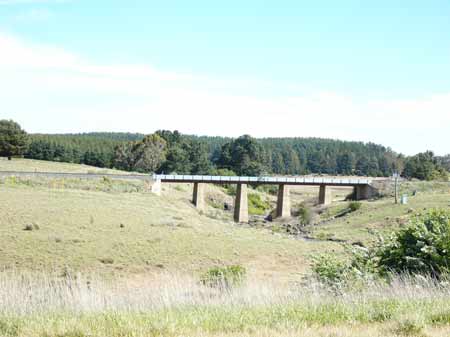
October 2004: Bostok Reservoir is also located inside Geelong's water supply catchment. Plantations at Bostok are owned by Barwon Water.

Bostok Channel downstream from the plantation. This channel transports water from Korweingboora to Reservoirs further downstream.
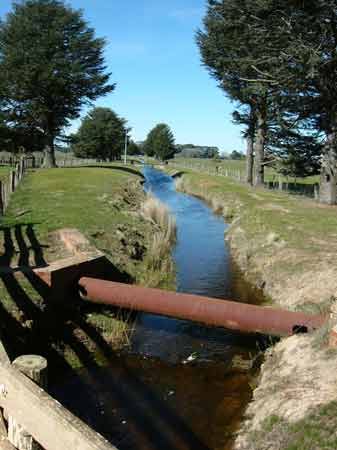
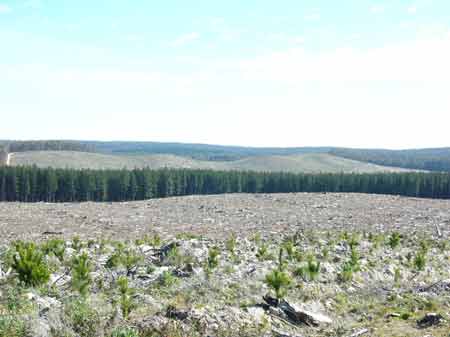
August 2007: Attractive vista looking west across Geelong's drinking water supply. Hexazinone residues are still being detected in the Moorabool River - 2 years after the herbicide was stopped being used.
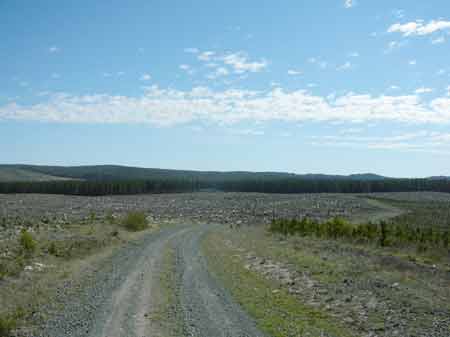
August 2007: View looking north into Geelong's drinking water catchment.
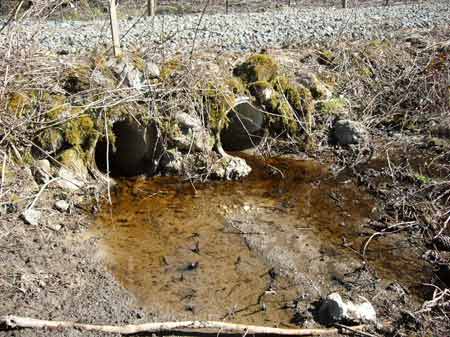
August 2007: Main drainage line under Reserve Track within a few hundred metres of Korweinguboora Reservoir. The water looks very tasty!

August 2007: Drainage line after logging near Reserve Track. Note lack of buffers.

August 2007: Tell tale signs of bulldozers operating through drainage line in close proximity to reservoir. How close will pesticides be sprayed to this drainage line?
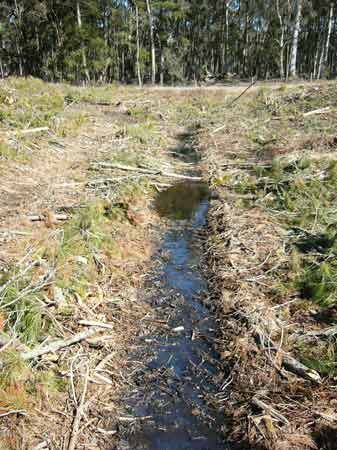
August 2007: More dozer tracks this time straight down the drainage line of the main waterway feeding into a reservoir that supplies the people of Geelong with drinking water.

August 2007: Close up of drainage line that was used as a dozer track in Geelong's water supply off Reserve Track.
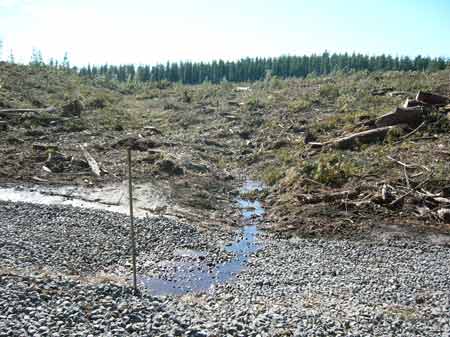
August 2007: Another drainage line off Reserve Track and more bad news for people wanting to drink water in Geelong.
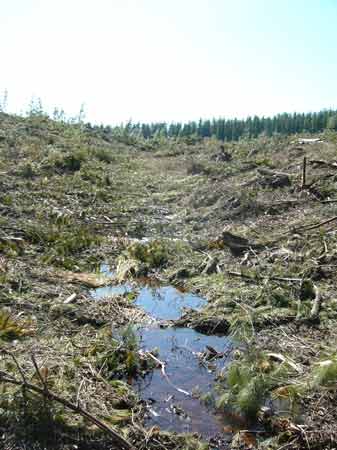
August 2007: Same drainage line with no buffers to protect stream water quality.
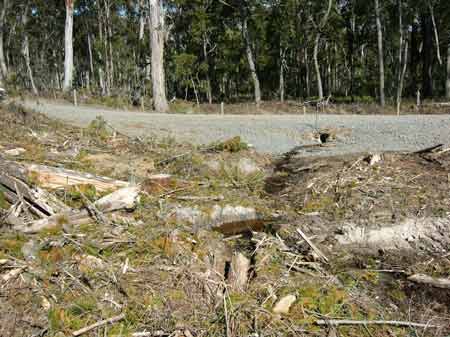
August 2007: Protection afforded drainage lines by Hancock. Who said plantations are good for water quality?
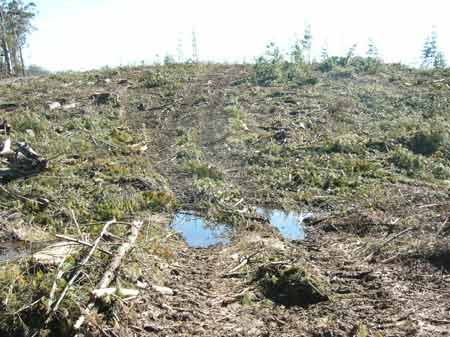
August 2007: Bulldozers had also driven through this drainage line compacting soil. This practice very likely breaches the Code of Forest Practices, but where are the responsible authorities?
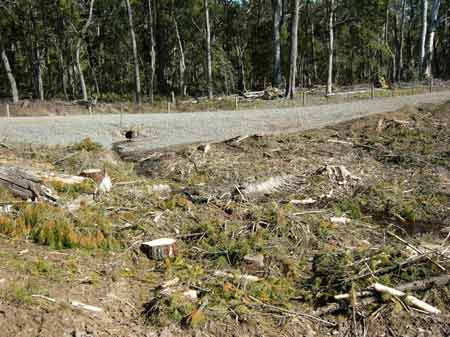
August 2007: Drainage line off Reserve Track. No buffers.

August 2007: Dozers also crossed drainage line at this point.

August 2007: And at this point.

August 2007: Oh and here as well.
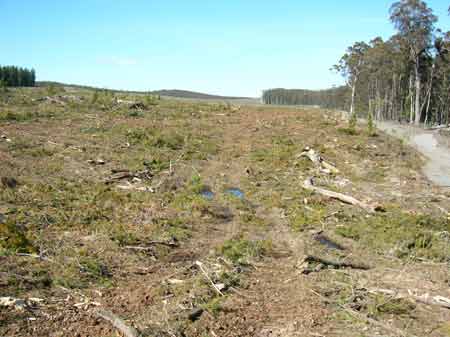
August 2007: And don't forget this one as well. Hancock Watch estimates that contractors drove through this drainage line at least 10 times.
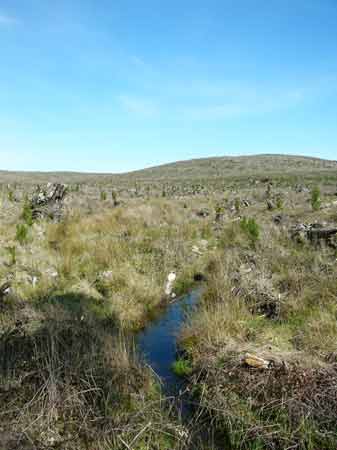
August 2007: Lack of buffers on western side of plantation. Is is any wonder this plantation leached hexazinone for so long? Note clearfell in background. This all drains eastward through unprotected drainage lines such as this.

August 2007: Low lying swampy ground on north side of plantation.
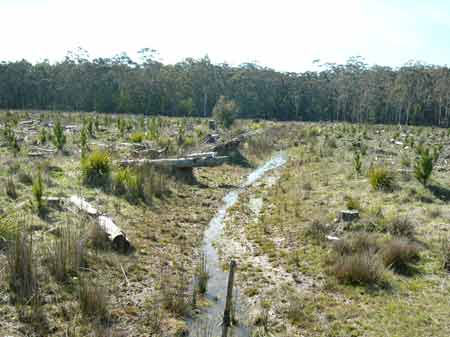
August 2007: Lack of buffers on drainage line near Float Track
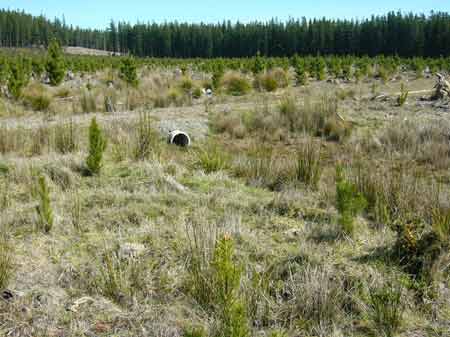
August 2007: ditto

August 2007: Float Track again.
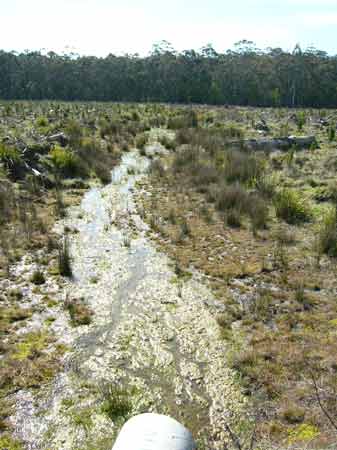
August 2007: Slime in waterline just off Float Track.
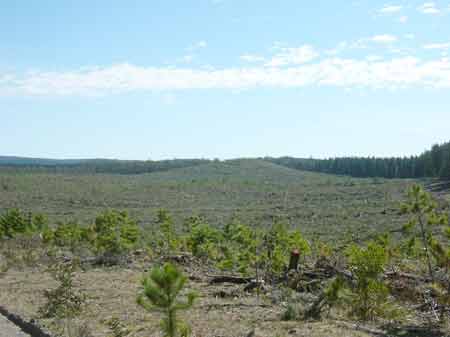
August 2007: View looking from Lynch Track
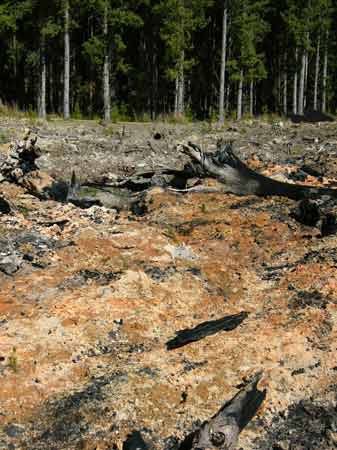
August 2007: A log dump was burnt in this drainage line on the west side of the plantation.